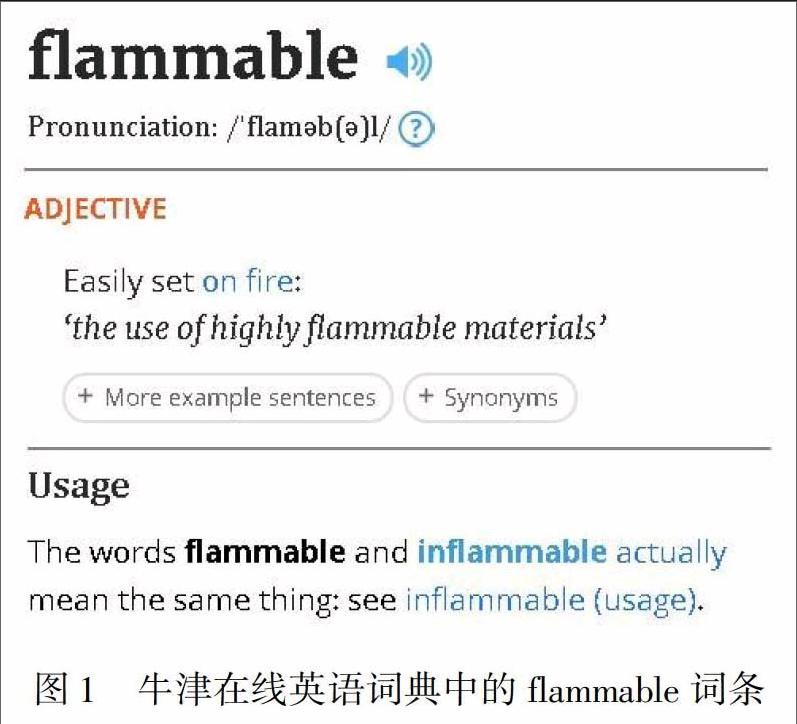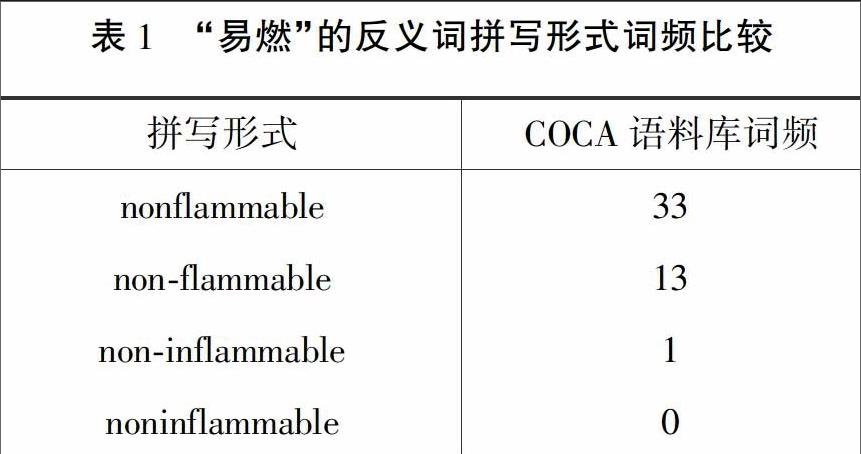基于在线英语词典和其他网络资源的词汇知识采集
2017-11-06马立东
马立东



摘 要:以发现flammable与其近义词的区别特征为例,探讨如何利用互联网采集和提炼英语词汇知识。首先,从形容词flammable和inflammable的构词特点及词源入手,探究两者的词义关系。接下来,结合语料库词频数据对比,检视两者使用频率的历时演变及现状。然后,通过词典释义对比、搭配用法和共现倾向分析,揭示在表达“易燃”时,形容词flammable与combustible的细微词义区别。此外,还根据语料库实例和词频找出flammable和combustible用作名词时的形态特点。结果表明:经计算机辅助分析和提炼,能够从在线英语词典、英语语料库及专业机构网站的相关网页等网络资源中采集到flammable与其近义词的区别特征等词汇知识。采集到的词汇知识对翻译、词典编纂和词汇教学具有参考价值。
关键词:词汇知识,易燃,翻译,在线词典,语料库,选词
中图分类号:H315.9 文献标识码:A DOI:10.3969/j.issn.1673-8578.2017.05.010
Gathering Lexical Knowledge from Online English Dictionaries and Other Internet Resources: Case Study of Discovering Features That Distinguish FLAMMABLE from Its Synonyms//MA Lidong
Abstract: This paper explores how to gather information from the Internet and transform it into lexical knowledge. The focus is on the case study of discovering the features that distinguish FLAMMABLE from its nearsynonyms. First, the origin and morphological structure of the adjectives flammable and inflammable are analyzed to identify how they are related semantically. Next, the diachronic changes in the frequency counts and the present status of the two words are examined. Then, the subtle difference between flammable and combustible is revealed by comparing the definitions of the two words, their collocations and cooccurrence tendency. In addition,according to corpus examples and word frequency, we also found out the morphological features of flammable and combustible used as nouns. Our study demonstrates that lexical knowledge can be extracted, by means of computerassisted analysis and information transformation, from informative resources on the Internet such as online English dictionaries, English corpora and specialized websites. The lexical knowledge obtained can be used for reference in translation, dictionary compilation and vocabulary teaching.
Keywords: lexical knowledge, flammable, translation, online dictionary, corpus, diction
易燃易爆物品容易引发火灾和爆炸事故。为了保证人身和财产安全,机场、车站和码头执行严格的安全检查,严禁旅客携带此类物品登机、乘车或上船。消防知识介绍、危险警示和事故报道常提到“易燃易爆物品”。“易燃易爆物品”的英译涉及选择用词问题。flammable和explosive的常见搭配名词中有多个可表达“物品”之意。例如material(s),substance(s),device(s),object(s),stuff,product(s),item(s),cargo,goods等。具体用词需要根据泛指程度和语境选用。“易爆”的英译很稳定,用explosive即可。但是“易燃”的英译有三个词可以选择:flammable,inflammable和combustible。目前已出版的设有“易燃”词条的汉英词典对flammable没有给予足够的重视:仅把inflammable和combustible作为释义词或英译对应词;现在使用频率更高的flammable未被收录或只在例证中出现。此外,combustible和flammable不是在任何语境中都可任意替换,但是现有汉英词典中未提供相关用法说明或提示。针对这种情况,本文探讨如何利用网络资源采集和提炼flammable与其近义词的区别特征,为翻译、词典编纂和词汇教学提供参考。关于可利用的网络资源及应注意的问题,王连江曾在《论网络在翻译选词中的应用》一文中介绍过[1]。本研究使用的网络资源主要是在线英语词典、英语语料库和專业机构网站的相关网页。endprint
一 形容词flammable与inflammable
(一)一对看似反义的近义词
根据牛津在线英语词典的释义和用法说明[2],flammable与inflammable的意思相同(The words flammable and inflammable actually mean the same meaning),它们都有“易燃(easily set on fire)”之意(见图1)。
利用牛津在线英语词典的参见指引“see inflammable (usage)”,在inflammable词条下可以查到更详细的用法说明。因为前缀in是个典型的否定前缀(例如:indirect和insufficient中的in都是否定前缀),所以inflammable 极易被误认为是flammable的反义词。但是,flammable和inflammable是一对看似反义的近义词。inflammable中的前缀in源自拉丁语,意为into,在英语中起强调词根的作用(has the effect of intensifying the meaning of the word in English)[3]。
形容词flammable的反义词是nonflammable,但是现在更常拼写成nonflammable,意为not likely to burn easily,not catching fire easily或not flammable (不易燃烧的;不易点燃或引燃的;不易燃的)。不仅如此,nonflammable/nonflammable也是inflammable的反义词。尽管英语中有noninflammable一词,但是这个词的发音很拗口,已过时,现在的使用频率很低。表1列出的是从当代美国英语语料库(COCA)(http://corpus.byu.edu/coca)中查到的“易燃”反义词拼写形式的词频对照数据(查询时间为2017年2月2日): (二)使用频率后来居上的flammable
牛津在线英语词典提供的词源信息显示,inflammable出现的時间要比flammable早约200年:inflammable是在17世纪早期经法语进入英语或源自拉丁语的inflammare[3];到19世纪早期才出现的flammable源自拉丁语的flammare[2]。
莫里斯(Morris) [4]和诺德奎斯特(Nordquist)[5]介绍过inflammable和flammable使用频率的历时演变。flammable刚出现的时候并没有被人们广泛接受。但是,第二次世界大战结束后,英美两国的安全官员(safety officials)和有关机构鼓励人们用flammable取代inflammable表达“易燃的”。这次推广运动(campaign)起了作用。flammable被越来越多地使用,而inflammable的使用频率则逐渐降低。
用《时代》(Time)周刊语料库(http://corpus.byu.edu/time)检索到的词频数据(查询时间为2017年2月2日)制作的折线图(见图2)显示:在20世纪20年代、30年代和50年代《时代》周刊没有使用过flammable,40年代只用了一次;但是从20世纪60年代开始,flammable的使用次数逐渐超过了inflammable,而inflammable的使用频率开始降低。到了20世纪80—90年代,flammable的使用频率已经大幅超过inflammable。但是,inflammable并没有被彻底取代,因为inflammable还可用于表达“易激动的;易激怒的;一触即发的”。曼瑟(Martin H. Manser)指出:用作这个比喻意义时,inflammable不能用flammable代替[6]137。在《时代》周刊语料库中,80年代共有两个应用实例,使用的都是inflammable的比喻义:(1)...to extinguish those inflammable humours which have so often kindled into war...(消除这些易引发战火的暴躁情绪);(2)...and coping with the inflammable situation in Lebanon(应对黎巴嫩一触即发的紧张局面)。90年代,《时代》周刊也是只有两个inflammable的应用实例:highly inflammable jet fuel(高度易燃的飞机燃油);The mood in the cabinet room was so tense that the air seemed almost inflammable(内阁会议厅内的气氛非常紧张,几乎是一触即发)。前一个实例中的inflammable意为“易燃的”。另一个实例中使用的是其比喻义“易激动的;易激怒的;一触即发的”。
用当代美国英语语料库的词频数据(查询时间为2017年2月2日)制作的折线图(见图3)显示:1990—2015年,flammable的使用频率一直大幅高于inflammable,而且这种情况已经趋于稳定。
(三)现在更广泛用于警示标识的flammable
根据牛津在线英语词典inflammable词条下的用法说明,flammable要比inflammable更常用,而且不易导致错误理解(Flammable is a far commoner word than inflammable and carries less risk of confusion)[3]。
柯林斯在线英语词典(https://www.collinsdictionary.com)flammable词条下的用法说明(见图4)还指出,人们更倾向于在警示标识(warning labels)上使用flammable这个词,因为它不像inflammable那样容易被误认为是“不易燃(not flammable)”的意思[7]。四)表达“易激怒的;易燃战火的”用inflammableendprint
虽然现在表达材料或物质“易燃”时,人们倾向于用flammable取代过去常用的inflammable,但是在表达“易激动的;易激怒的;易燃战火的;一触即发的”这个比喻义时,一般不用flammable代替inflammable(参见前文第二小节)。
在当代美国英语语料库中查到的应用实例里,inflammable多用于表达“易燃的”。例如:a suitcase bomb containing some kind of inflammable material(一颗放在手提箱里含有某种易燃材料的炸弹);the spontaneous combustion of an inflammable gas (易燃气体的自燃)。inflammable也用于表达“易激怒的;一触即发的;易燃战火的”。例如:a very inflammable situation(一个非常敏感、一触即发的紧张局面);the worlds most inflammable region (世界上最易燃战火的地区)。
二 形容词flammable与combustible
(一)比combustible更強调“易燃”的flammable
因为有些可燃物质相比之下更易燃,易燃物质必定是可燃物质,所以flammable和combustible有通用的时候。
但是,细分起来,flammable比combustible更强调“易燃”。differencebetween网站用一句话概括了flammable与combustible的联系和区别:“All flammable substances are surely combustible, but all combustible substances are not essentially flammable”[8](易燃物质必定是可燃物质,但是并非所有可燃物质都易燃)。
可燃物质(combustible substances)指燃点较高,遇到火源或高温热源能发生燃烧,但燃烧速度较慢的物质,品种繁多。易燃物质(flammable substances)指接触到火源或高温热源能迅速发生燃烧的物质。根据加拿大Health Canada网站的介绍[9],柴油(diesel fuel)和煤油(kerosene)是常见的可燃液体(common combustible liquids);汽油(gasoline)和松节油(turpentine)是常见的易燃液体(common flammable liquids)。易燃液体易挥发,在正常工作温度下很容易被点燃或引燃。可燃液体不如易燃液体容易着火(A combustible liquid does not catch fire as easily as a flammable liquid)。换句话说就是:易燃液体比可燃液体更容易点燃(A flammable liquid is even easier to ignite than a combustible liquid)。
牛津在线英语词典对flammable的释义是“Easily set on fire. ”(易燃的;容易点燃的),对combustible的释义是“Able to catch fire and burn easily. ”(可燃的;易燃的;能点燃,易燃烧的)。柯林斯在线英语词典的释义与此类似,分别是“liable to catch fire; readily combustible; inflammable”(易燃的)和“capable of igniting and burning”(可燃的;可点燃和燃烧的)。可见,从精确释义的角度,flammable比combustible更强调“易燃”。
形容词flammable比combustible更强调易燃性这一点还可以从这两个词的连用表达方式中得到印证。从当代美国英语语料库中查到的典型实例有:flammable and combustible liquids(易燃可燃液体;易燃液体及可燃液体);flammable and combustible gases (易燃可燃气体;易燃气体和可燃气体);flammable or combustible materials (易燃可燃材料;易燃或可燃材料);can become flammable or combustible (可以变得易燃或可燃)。
(二)flammable和combustible共有的句法特征
形容词combustible和flammable都可用作表语,也常用作定语。
无论是用作表语还是定语,它们都可以被extremely、highly、very等程度副词修饰,从而更精确地表达“易燃”的程度相对很高。例如:upholstery foam is highly combustible (室内装饰泡沫非常易燃);highly combustible household waste such as plastic(高可燃性生活垃圾,例如废塑料);dried flowers, corn stalks and crepe paper are highly flammable (干花,玉米秸秆和皱纹纸高度易燃);highly flammable hydrogen (高度易燃的氢气)。
形容词combustible和flammable还可以被more或less修饰或用于比较结构,表达相比之下“更易燃”或“不如……易燃”。例如:the more combustible plywood (更易燃的胶合板);gasoline is more flammable under some conditions, kerosene under others (在某些条件下汽油更易燃,而在其他特定条件下煤油更易燃);set it on fire to demonstrate that it was less flammable than gasoline (把它点燃,来证明它不如汽油易燃)。endprint
三 用作名词的flammable和combustible
flammable和combustible不仅常用作形容词,也可用作名词,用作名词时常用复数形式。下面是当代美国英语语料库中的四个典型实例:combustibles soaked with petroleum (石油浸泡过的可燃物);four types of waste—combustibles, noncombustibles, recyclable glass bottles and cans, and PET bottles(四类废弃物:可燃物,不可燃物,可回收的玻璃瓶和易拉罐,以及聚酯瓶);waste papers and other flammables(废纸等易燃物);a device to detect weapons, liquid explosives and flammables in containers found in carryon baggage or passengers effects(一種装置,用于探查旅客的随身行李或个人物品中的包装物或容器里是否有武器、液体炸药和易燃品)。
当代美国英语语料库的查询结果还显示:flammables和combustibles的词频分别是15和27,而inflammables的词频为零。此外,COCA中flammables and explosives 和explosives and flammables的应用实例各有一个,但没有查到combustibles与explosives共现连用的实例。
四 结 语
经计算机辅助分析和提炼,可从在线英语词典、英语语料库及专业机构网站的相关网页等网络资源中采集到flammable与其近义词inflammable和combustible的区别特征等词汇知识。要点如下:(1)用于表达“易燃”之意时,flammable与inflammable同义,可以相互替换使用,但inflammable是个旧术语。(2)inflammable中的前缀in意为into,起强调词根的作用,而不是常见的意为not的否定前缀。为避免有人错把inflammable当作not flammable的意思,现在倾向于用flammable取代inflammable。(3)形容词flammable的反义词是nonflammable,但是现在更常拼写成nonflammable。(4)因为可燃物质中有些是易燃物质,易燃物质必定是可燃物质,所以combustible和flammable有通用的时候。但是,combustible强调可燃性,而flammable更强调易燃性。(5)flammable和combustible常用作形容词,也可用作名词,用作名词时常用复数形式。
上述词汇知识要点不仅有助于在翻译“易燃易爆物品”时选择适合语境的用词,对词典编纂和词汇教学也有参考价值。关注英语词汇的历时变化,利用多种网络资源进行分析、提炼和验证,可以丰富英语或汉英词汇知识库的内容,值得进行系统研究。
参考文献
[1] 王连江. 论网络在翻译选词中的应用[J]. 重庆三峡学院学报, 2013(2):99-102.
[2] Flammable [EB/OL]. [2017-02-02]. https://en.oxforddictionaries.com/definition/flammable.
[3] Inflammable [EB/OL]. [2017-02-02]. https://en.oxforddictionaries.com/definition/inflammable.
[4] Morris E. An alarming situation [EB/OL]. (1998-12-03) [2016-10-20]. http://www.worddetective.com/120398.html.
[5] Nordquist R. Flammable, Inflammable, and Nonflammable (Commonly Confused Words) [EB/OL].(2016-04-28) [2017-01-15]. http://grammar.about.com/od/alightersideofwriting/a/FlammableInflammableAndNonflammable.htm.
[6] [英]曼瑟. 英语词汇用法辨析手册[M]. 丁大刚,等译. 上海:世界图书出版公司, 2007:137.
[7] Flammable [EB/OL]. [2017-02-02]. https://www.collinsdictionary.com/dictionary/english/flammable.
[8] Difference Between Flammable and Combustible [EB/OL]. [2017-01-15]. http://www.differencebetween.net/science/differencebetweenflammableandcombustible.
[9] Flammable and Combustible Liquids [EB/OL]. (2006) [2017-01-05]. http://hcsc.gc.ca/ewhsemt/occuptravail/whmissimdut/flamcombliquidseng.php.endprint
